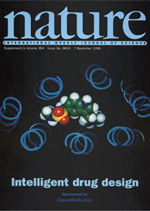Supplements
Intelligent drug design: A Nature supplement
Vol. 384, No. 6604 (7 Nov. 1996)

In this supplement
Developments in techniques of pharmaceutical chemistry have revolutionized the design of drugs beyond previous expectations. But what are our current expectations and what does the future hold? Glaxo Wellcome has set itself the objective of introducing three significant new medicines a year, every year, by 2000.
Glaxo Wellcome's Research
Redesigning drug discovery p1
Glaxo Welicome has set itself the objective of introducing three significant new medicines a year, every year, by 2000.
Robotic screening p2
Bioinformatics p3
Combinatorial chemistry p3
Systematization of research p5
Top of page
Introduction
For medicinal purposes p7
Developments in techniques of pharmaceutical chemistry have revolutionized the design of drugs beyond previous expectations. But what are our current expectations and what does the future hold?
Gregory A. Petsko
Top of page
Progress
The combinatorial chemistry of nature p11
Technologies such as combinatorial chemistry are changing the face of drug discovery. But natural products still offer unmatched structural variety, especially as new environmental niches are explored, and their usefulness can be further extended by engineering the proteins that produce them and by using them to probe biological pathways.
Gregory L. Verdine
High-throughput screening for drug discovery p14
Progress in elucidating the basis of human diseases has vastly increased the number of potential drug targets, while new approaches have increased the number of compounds that can be tested for activity against these targets. Together, these trends have turned high-throughput screening into a primary tool for early-stage drug discovery.
James R Broach & Jeremy Thorner
Directed combinatorial chemistry p17
Combinatorial chemistry has given chemists access to vast numbers of molecules, but selecting the right one has proved more difficult. As chemists have gained experience in the technique, however, it has become possible to use solid- or solution-phase syntheses with different chemistries and scaffolds to produce libraries tailor-made for finding or optimizing a lead directed at almost any class of target.
Joseph C. Hogan Jr
In pursuit of antisense p20
The first generation of antisense oligodeoxynucleotides (ODNs) are now in clinical trials, but their effects may reflect biological activities unrelated to their ability to bind RNA. Nevertheless, preclinical animal studies now suggest that phosphorothioate ODNs may be more permeable in certain animal tissues than in cell culture, raising hopes that antisense mechanisms can be exploited pharmacologically.
Mark D. Matteucci & Richard W. Wagner
Structure-based drug design p23
The three-dimensional structures of more than 4,000 macromolecules have already been solved, and the number will continue to increase steadily. Many of these macromolecules are important drug targets and it is now possible to use the knowledge of their three-dimensional structure as a good basis for drug design.
Tom L. Blundell

